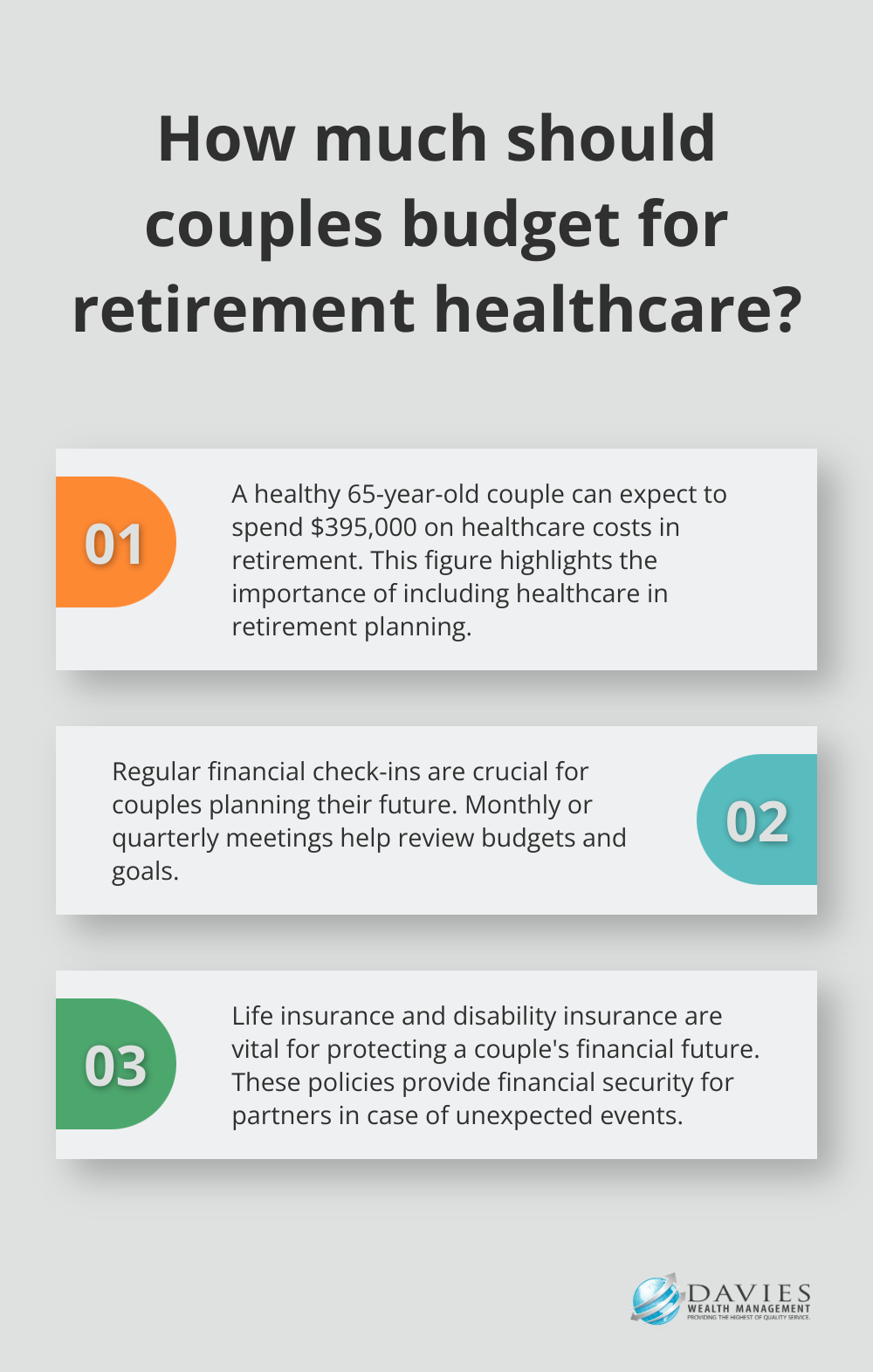At Davies Wealth Management, we understand that couples financial planning can be a challenging yet rewarding journey. Creating a solid financial plan together is a crucial step towards building a secure future and strengthening your relationship.
In this guide, we’ll explore practical strategies for couples to effectively manage their finances, set shared goals, and navigate potential challenges along the way. Whether you’re newlyweds or long-term partners, these insights will help you build a strong financial foundation together.
How to Talk Money with Your Partner
Schedule Regular Money Talks
Set aside time each month for financial discussions. These “money dates” should occur in a distraction-free, stress-free environment. Choose a neutral setting, like a quiet café or a peaceful spot at home. The goal is to create an atmosphere where both partners feel at ease to share their thoughts and concerns about your shared finances. Regular money talks should be calm and respectful, with both partners validating each other’s feelings and seeking compromise where possible.
Share Your Financial Histories
Be open about your financial past. Discuss your upbringing, how your family handled money, and any past financial mistakes or successes. This transparency helps build understanding and empathy. Share Your Financial Histories openly to align your financial journeys. It’s extremely important for partners to communicate about money to ensure they’re on the same page.
Define Your Shared Vision
Work together to outline your short-term and long-term financial goals. Do you want to buy a house in the next five years? Are you planning to start a family? Maybe you dream of early retirement or starting a business. Write these goals down and prioritize them together. This shared vision will guide your financial decisions and help you stay aligned in your money management. Define Your Shared Vision by openly sharing spending habits, credit scores, and any debt being brought into the relationship.
Address Individual Concerns
Each partner should have the opportunity to express their financial worries or aspirations. One might prefer conservative investments (due to risk aversion), while the other might feel comfortable with higher-risk, higher-reward strategies. Acknowledge these differences and find compromises that respect both perspectives.
Establish Ground Rules
Create a set of financial ground rules that both partners agree to follow. This might include setting a spending limit for individual purchases without consultation, deciding how to split shared expenses, or agreeing on a savings target. These rules provide a framework for your financial decisions and help prevent misunderstandings.

Open communication forms the foundation of successful financial planning for couples. By establishing this foundation, you’ll equip yourselves to tackle the practical aspects of managing your money together. In the next section, we’ll explore strategies for combining finances and creating a shared budget that aligns with your goals and values.
Merging Money as a Couple
Joint vs. Separate Accounts: Finding the Right Balance
When couples combine finances, there’s no universal solution. At Davies Wealth Management, we’ve observed various strategies succeed for different pairs. The optimal approach aligns with your shared objectives and individual comfort levels.

Many couples debate whether to merge all accounts or maintain some separation. Both methods have advantages. Joint accounts promote transparency and simplify shared expense management. A TD Bank study found that 76% of couples who share at least one bank account report being extremely or very happy in their relationships.
However, separate accounts can preserve financial independence. This approach allows each partner to have personal spending money without justification for every purchase.
A popular compromise is the “yours, mine, and ours” method. This involves individual accounts for personal expenses and a joint account for shared costs (rent, utilities, groceries). Each partner contributes an agreed-upon percentage of their income to the joint account, ensuring fairness even with income disparities.
Creating a Shared Budget: The Foundation of Financial Harmony
After deciding on your account structure, create a shared budget. Start by listing all income sources and fixed expenses. Then, allocate funds for savings goals and discretionary spending.
Budgeting apps like Mint or YNAB (You Need A Budget) can help track spending together. These tools sync multiple accounts and provide real-time updates on your financial status. (While these apps are popular, Davies Wealth Management offers personalized budgeting assistance tailored to your specific needs.)
Dividing Financial Responsibilities: A Team Effort
Clear division of financial tasks prevents misunderstandings and ensures thorough coverage. One partner might handle day-to-day expenses and bill payments, while the other focuses on long-term investments and retirement planning.
Regular check-ins are essential. Schedule monthly “money dates” to review your budget, discuss concerns, and adjust your strategy as needed. This ongoing communication keeps both partners engaged and informed about your shared finances.
Adapting to Change: Flexibility in Financial Planning
Merging finances requires patience and flexibility. Your current system might need adjustments as circumstances change. Try to create a system that supports your financial goals while strengthening your relationship.
As you navigate the complexities of merging finances, remember that professional guidance can be invaluable. In the next section, we’ll explore how couples can plan for their future together, including setting long-term financial goals and addressing retirement planning.
Building Your Financial Future as a Team
Defining Your Financial Milestones
Start by outlining your short-term and long-term financial objectives with your partner. Short-term goals might include saving for a vacation, paying off credit card debt, or building an emergency fund. Long-term goals could encompass buying a home, funding your children’s education, or retiring comfortably.

Be specific when you set these goals. Instead of saying “save for retirement,” define how much you want to have saved by a certain age. This clarity helps you create actionable plans and measure progress.
Crafting Your Retirement Strategy
Retirement planning as a couple requires a unified approach. Begin by assessing your current retirement savings and estimating your future needs. A healthy 65-year-old couple can expect to spend upwards of $395,000 on healthcare costs in retirement alone.
Consider factors like your desired lifestyle, potential healthcare costs, and longevity when you plan. If one partner has access to a 401(k) with employer matching, try to maximize those contributions. For those without employer-sponsored plans, Individual Retirement Accounts (IRAs) offer tax advantages worth exploring.
Don’t forget to account for Social Security benefits in your planning. The Social Security Administration provides tools to estimate your benefits based on your earnings history.
Protecting Your Future with Estate Planning
Estate planning isn’t just for the wealthy. It’s important for ensuring your assets are distributed according to your wishes and minimizing potential conflicts. Start by creating wills and consider setting up trusts if appropriate for your situation.
Review your beneficiary designations on retirement accounts and life insurance policies regularly (especially after major life events like marriage or the birth of a child).
Safeguarding Your Financial Future with Insurance
Insurance plays a vital role in protecting your financial future. Life insurance can help ensure dependents are taken care of financially if something happens to you. The payout from a life insurance policy can provide financial security for your partner.
Disability insurance is often overlooked but equally important. Having adequate coverage can protect your income and financial goals if you’re unable to work due to illness or injury.
Regular Review and Adjustment
Planning for your future is an ongoing process. Schedule regular financial check-ins, such as monthly or quarterly meetings, to discuss your financial status and review your budget and goals. Work together and stay committed to your shared goals to build a secure and prosperous financial future as a couple.
Final Thoughts
Couples financial planning requires open communication, shared goals, and adaptability. Regular money talks establish financial transparency and trust, while sharing financial histories and defining a shared vision align goals and values. Finding the right balance between joint and separate accounts is essential, as is creating a shared budget that reflects your priorities.

Planning for your future together involves setting clear financial milestones, crafting a comprehensive retirement strategy, and protecting your assets. As life circumstances change, your financial plan should evolve. Professional help can guide you through complex financial decisions.
At Davies Wealth Management, we specialize in tailored financial advice for couples, families, and individuals (including professional athletes with unique financial needs). Our team can help you create a comprehensive financial plan that aligns with your goals and ensures your financial security at every stage of life. You’ll be well-equipped to tackle any financial challenges and achieve your long-term financial dreams together.



Leave a Reply